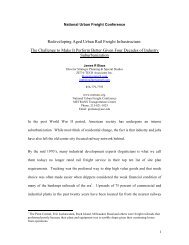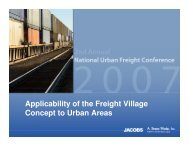Table of Tables - METRANS Transportation Center
Table of Tables - METRANS Transportation Center
Table of Tables - METRANS Transportation Center
You also want an ePaper? Increase the reach of your titles
YUMPU automatically turns print PDFs into web optimized ePapers that Google loves.
Evaluating the Feasibility <strong>of</strong> Electrified Rail at the<br />
Port <strong>of</strong> LA/LB<br />
cost <strong>of</strong> hi gh vot age ove rhead caternary, sites t he cos t <strong>of</strong> electrification as $ 400k/mile<br />
($614k/mile in 2008 dollars).<br />
A more recent and far more deatailed overhead caternary estimate for rail retr<strong>of</strong>it comes<br />
from t he Lakeshore Corridor commuter r ail l ine i n T oronto C anada. T he l ine ha s<br />
operated for several years as a “Deisel-pulled” passenger system. For both economic and<br />
environmental r easons, it is presently being r etr<strong>of</strong>it t o an electric rail line tha t us es<br />
electric lo comotives. The cost es timates refered to as R ough Order <strong>of</strong> M agnetude<br />
Estimates ( ROMEs) w ere ba sed on exceptionally detailed cost data, as e xemplified in<br />
Appendix B, in that this project is going forward with the retr<strong>of</strong>it. <strong>Table</strong> 3 summerizes<br />
those de tailed estimates <strong>of</strong> ove rhead c aternary distribution c ost for 556 S ingle Track<br />
Kilometers (STK) or 17 3 doubl e t rack m iles, to a llow c omparison with pr evious d ata.<br />
The c onversion o f t he 2008 C anadian dol lar (CD) to U S dol lar (USD) involves t he<br />
exchange rate <strong>of</strong> .9426 USD to one CD at that time. Thus the overhead caternary costs <strong>of</strong><br />
$149M CD (second row <strong>of</strong> <strong>Table</strong> 3) for 556 STK converts to $812k/mile in 2008 USD.<br />
<strong>Table</strong> 3- Rough Order <strong>of</strong> Magnitude (ROME) Cost <strong>of</strong> Caternary Installation<br />
(Second Row) and Substation (First Row) Analysis <strong>of</strong> a 173 Double Track Mile<br />
Section <strong>of</strong> the Toronto Lakeshore Line Electrification Retr<strong>of</strong>it<br />
5.3 Estimate <strong>of</strong> Single Diesel-Electric Locomotive Conversion to Hybrid<br />
Electric Locomotive for Third-Rail and/or Overhead Caternary<br />
Operation<br />
The previously described “electro-Diesel” locomotives ha ve be en m anufactured b y bot h<br />
General Electric and General Motors engines, costing about $2M each. A small number <strong>of</strong><br />
these could have direct application for electrified rail movement at the Port and in the Los<br />
Angeles basin as shuttle train engines. The class one rails, however, rather than using these<br />
proven hybrid locomotives for shuttle trains to move containers and form long haul trains<br />
outside <strong>of</strong> urban areas might be “hiding behind the need for absolute perfection” to both<br />
avoid major operational shifts and inflate electric locomotive costs. While the safety and<br />
geometric c omplexities <strong>of</strong> us ing e lectric loc omotives f or tr ain formation at the P ort<br />
complex prohibits electrification; short distances from terminals to the ICTF and SCIG, as<br />
well as the Alameda Corridor are reasonable candidates for electrification. These candidate<br />
routes considered here presently carry full-length trains intended to leave the Ports and the<br />
LA basin for transcontinental travel. To avoid economically and spatially costly exchange<br />
19




